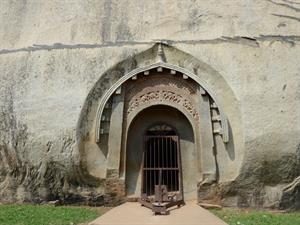PDF chapter test TRY NOW
The Philosophy of the Ajivikas:
The Ajivikas are a group of people who existed as contemporaries of Jains and the Buddhists. It was considered as a school of thought which emphasized the determinism and transmigration of the Souls.
They also followed the “Nastika Philosophy” which out-rightly rejected the authority of the Vedas.
Gosala Mankhaliputta: He was believed to be the founder of the Ajivika sect. He was also a contemporary and a friend of Mahavira, the last Jain Tirthankara.
Ajivikas strongly advocated that “a cosmic force is controlling the entire universe” which they named “Niyati”. They also went on to say that the Niyati was a determinant of everything including an individual’s fate.
The details regarding the Ajivikas can be seen in Aranyakas and Brahmanas which belong to the later Vedic period. Ironically the literature of the Ajivikas is not preserved.
The Mauryan Patronage:

Barabar Caves
One of the Oldest empires of India, the Mauryan empire extended strong patronage towards the sect of the Ajivikas. The Mauryan King Bindusara was a huge patron of the sect as he donated caves for the dwelling of the Ajivika monks.
Later the Patronage to the sect was extended by his son Ashoka the Great and his grandson Dasaratha. They donated more dwelling places and ameliorated their living.
Barabar Caves: The Barabar caves of Bihar which belonged to the Mauryan empire was donated for the dwelling of the Ajivikas by the Mauryan kings.
Later the sect of Ajivikas declined substantially as the following empires didn’t extend their patronage post the Mauryan empire.
The Fall of the Ajivikas:
1. The Ajivika monk practised asceticism of the highest order like lying on a bed made of nails, exposing them to extreme weather events and not wearing clothes.
2. Post the decline of their status in North India they moved towards the south where they faced persecution from all ends.
3. The Southern Kingdoms like the Chola, Pallavas and the Pandyas were followers of the Shaiva and Vaishnava cult and hence they didn’t encourage the existence of this sect and imposed taxes and other restrictions on them.
4. The Ajivikas managed to live near the areas of Kanchipuram and Vellore where the Jains also co-existed with them in some places.
5. Later the rise of the Bhakti movement in Southern parts of Tamil Nadu further curbed the existence of Ajivikas in the south which slowly merged into Vaishnavism.
